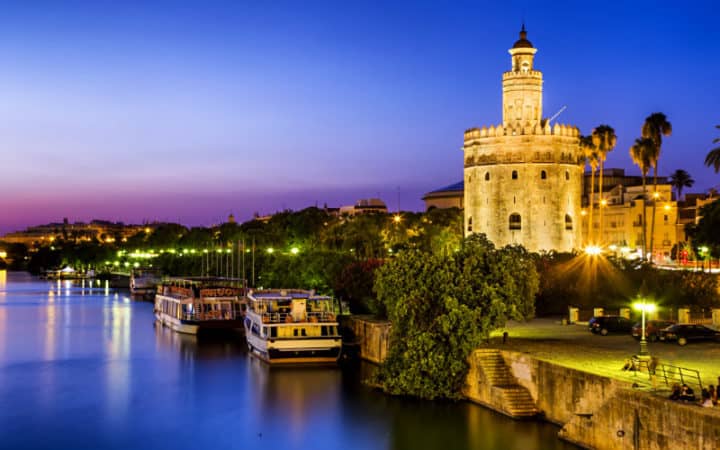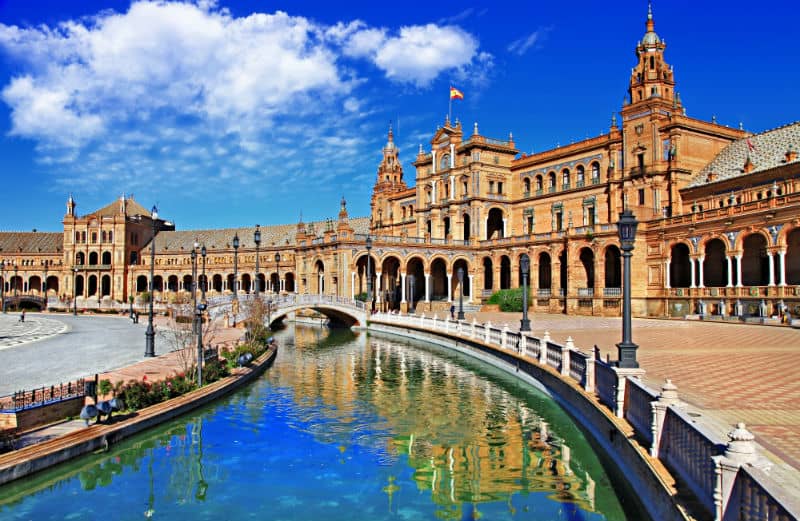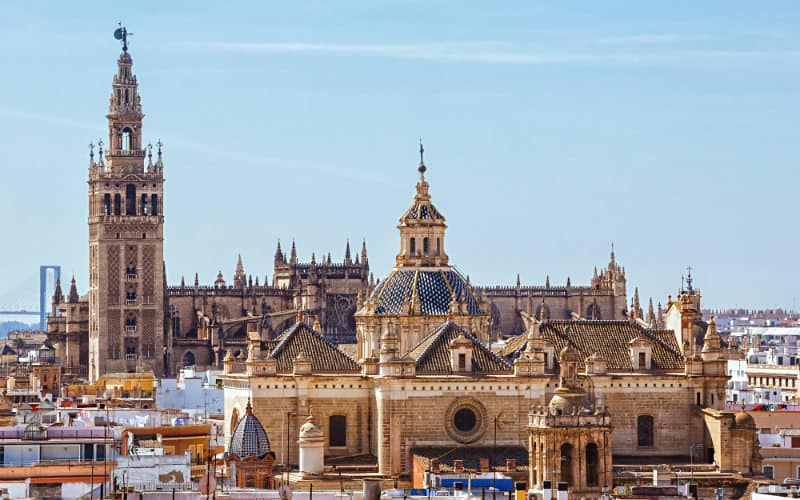
Gay Seville · City Guide
First time in Seville? Then our gay Seville city guide page is for you.
 view of Golden Tower (Torre del Oro)
view of Golden Tower (Torre del Oro)
Sevilla | Seville
The capital of Andalusia and the centre of a metropolitan region of 1.5 million people, Seville is the 4th largest city in Spain.
With a Moorish invasions and occupations dominating the Medieval period, Seville has a rich history with Spain’s greatest writer Cervantes spending most of his life here.
Nowadays, Seville is a favorite destination for tourist, both Spanish and international. Those who come are drawn to it's fantastic architecture, relaxed lifestyle, cosmopolitan cafe culture and flamboyant gay scene.
Gay Rights in Spain
For information about gay rights in Spain, please go to our Gay Madrid City Guide page.
Gay Scene
Although Torremolinos may lay claim to the gay capital of Andalusia, the gay scene of Seville is by no means taking a siesta. The majority of Seville's gay venues are concentrated around Alameda de Hercules and are open well into the night.
Here in Seville you will find a decent selection of Gay Bars, Gay Dance Clubs, Gay Cruise Clubs and Gay Saunas. There is also a Spanish language course aimed specifically at gay travelers, if you fancy extending your stay and brushing up on a bit of Spanish.

Getting to Seville
By plane
Seville Airport (SVQ), or San Pablo Airport, is located 10km north east of the city. It is well-connected to European destinations by both the major flag carriers and by the budget airlines as well.
Bus line EA takes you from the airport into the city centre with the bus stop just outside of the terminal. The journey takes 30 minutes and services run from 4.30am to 1.15am. Singles cost €4 and can be bought from the driver.
A taxi is quickest way to get into the city centre, although this is the most expensive. Journeys take half an hour and will cost €20-25 depending on traffic. The taxi rank is also just outside of the terminal.
By train
The Santa Justa Railway Station has high-speed rail connections to and from mainland Spain's major cities. There are no direct international connections from Seville.
Getting around Seville
On foot
A city as charming as Seville is best explored by foot. The city is relatively compact so walking from site to site will not take you long. You may wish to take transport, however, if the sweltering summer heat is too much or if you are burdened with heavy luggage.
By metro
Seville's metro system is currently being expanded but is still an effective means of getting around. Singles start from €1.35 depending on how many zones you cross and all-zone day passes are €4.50. Services run from 6:30am to 11pm in the week with later trains at the weekend.
By bus
Seville has an extensive bus network with several easy to navigate circular routes. Tickets start from €1.40 and can be bought on board. Services run from 6am to 11.30pm with night services running until 2am. To save money you can get a multi-voyage card for both tram and bus travel.
By tram
Seville's tram service is confusingly called Metro-Centre but is unconnected to the metro system and respective tickets won't apply on each mode of transport. You can get a ticket from the station for €1.20. Services run 6am to 1.30am.
By horse
An emblematic image of Seville is that of it's horses and carriages. While certainly a romantic means of getting around we would ask you to spare a thought for the horses and avoid this method in the sweltering summer heat.
 Tower Giralda Cathedral
Tower Giralda Cathedral
Where to Stay in Seville
For some of the best Seville hotel selections for gay travelers, visit our Gay Seville Hotels page.
Things to See & Do
Cathedral and La Giralda - an impressive feat of architecture that was built on the remains of the old mosque. La Giralda used to be the minaret and offers spectacular views. The cathedral is also notable for being the final resting place of Christopher Columbus.
The Real Alacazar - fantastic 14th Century palace built in Moorish style where Christopher Columbus planned his journey to the Americas. It has many rooms, gardens, courtyards and ponds to explore and is a good bet to escape the heat.
Plaza de España - well-known public square that you may recognize as a filming location in the Star Wars prequel trilogy.
Parque María Luisa - built for the 1929 Iber-Americano World Fair this park is now dotted with beautiful monuments and fascinating museums.
Museo de Bellas Artes - considered by many to be the most important museum in Spain after Madrid's El Prado. This museum is a former convent that hosts an excellent selection of Sevillan art from the Gothic period to the early 20th Century.
Museo del Baile Flamenco - another of Seville's iconic images is that of the flamenco dancer and here you can find out the history of one of the world's most famous dances. On Friday and Saturday evenings there are live performances.
When to Visit
Seville is known as the warmest metropolitan area in Western Europe which results in average summer highs of 35°C. We would recommend visiting in spring or fall when the temperature is cooler and tourists are less plentiful. Winters are cool but tend to be wetter.
Like much of Spain, there are a variety of fiestas and events held throughout the year with religious Easter processions and the Festival of April juxtaposing the solemn with the carnivalesque. The city hosts a gay Pride festival in June.
Money
Spain is a Euro area country. Cash dispensers are widely available. Credit and debit cards are widely accepted. Hotels, banks and some local businesses also operate foreign exchange desks.
Join the Travel Gay Newsletter
Have we got something wrong?
Are we missing a new venue or has a business closed? Or has something changed and we have not yet updated our pages?Please use this form to let us know. We really appreciate your feedback.